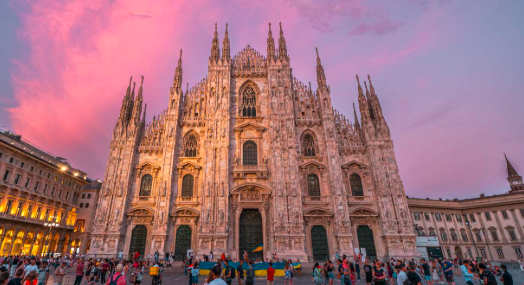
Top 3 Fantastic Travel Attractions in Milan
Milan, the capital of Italy’s Lombardy region, is a vibrant city that beautifully blends its rich history with modern sophistication. Known primarily as a global fashion hub, Milan is home to iconic landmarks such as the majestic Duomo di Milano, an impressive Gothic cathedral that took nearly six centuries to complete. Visitors can ascend to its roof for panoramic views of the city skyline and the nearby Alps. The city also boasts the stunning Galleria Vittorio Emanuele II, one of the world’s oldest shopping malls, where you can find luxury brands and enjoy a coffee at a quaint café. Don’t miss the opportunity to see Leonardo da Vinci’s “The Last Supper,” housed in the Convent of Santa Maria delle Grazie—an encounter with artistry that is as profound as it is essential. After a day of exploration, the vibrant nightlife in areas like Navigli promises lively bars and exquisite dining experiences, making Milan a city that caters to every taste.
To reach this enchanting city, travelers will be pleased to know that Cathay Pacific provides flight services from Brisbane To Milan ensuring your journey is both comfortable and efficient. Once you arrive, navigating Milan’s extensive public transport system, including trams and subways, is a breeze, allowing you to explore the city with ease. With a blend of art, culture, and culinary delights, Milan captures the hearts of visitors from all over the world. Whether you are here to indulge in high fashion, enjoy world-class cuisine, or admire stunning art and architecture, the city has something special for everyone. Be sure to wander through the charming streets of Brera, known for its artistic vibe, or visit the modern architectural marvels at Porta Nuova. No matter your interests, Milan promises an unforgettable experience that will leave you longing to return.
Teatro alla Scala
Teatro alla Scala, commonly referred to as La Scala, is one of the most prestigious opera houses in the world, located in Milan, Italy. Established in 1778, the theater was built under the guidance of architect Giuseppe Piermarini, replacing the older Teatro Regio Ducale. The official opening night on August 3, 1778, featured Antonio Salieri’s opera “L’Europa Riconosciuta,” marking the beginning of La Scala’s rich legacy in the world of performing arts. Over the centuries, it has hosted numerous iconic performances, featuring illustrious composers, conductors, and singers who have made their mark on the world of opera.
La Scala is not only renowned for its exceptional acoustics and grand architecture but also for its role in the cultural fabric of Italy. The theater has been a launching pad for many famous operas, including works by Giuseppe Verdi and Giacomo Puccini. Verdi, in particular, had a deep connection with La Scala; his early operas were premiered here, and he continued to influence the theater’s programming through the years. The theater’s commitment to showcasing both classic masterpieces and contemporary works ensures that it remains a vibrant part of the global cultural scene.
The interior of La Scala is equally breathtaking, characterized by its opulent décor, adorned with lavish red and gold furnishings, intricate chandeliers, and frescoed ceilings. The auditorium is shaped in a horseshoe design, enhancing the acoustics and ensuring an intimate experience for the audience. In addition to its opera performances, La Scala also hosts ballet and concerts, contributing to its reputation as a multi-faceted cultural institution. The adjacent Museo Teatrale alla Scala houses memorabilia, costumes, and musical instruments, providing visitors a glimpse into the rich history of the theater.
La Scala continues to be a beacon of artistic excellence, drawing opera lovers and visitors from around the globe. Its significance in the world of music and performance art transcends borders, making it a symbol of Italy’s rich cultural heritage. With an ongoing commitment to innovation and quality, La Scala not only preserves its storied past but also embraces the future of the performing arts, ensuring that it will remain a vital part of the artistic landscape for generations to come.
Duomo di Milano
The Duomo di Milano, or Milan Cathedral, stands as a stunning testament to Gothic architecture and remains one of Italy’s most iconic landmarks. Constructed over six centuries, its intricate façade is adorned with thousands of statues, spires, and gargoyles, showcasing the skill and artistry of various architects and artisans. The cathedral was first commissioned in 1386, and while the main structure was completed in the late 19th century, it reflects a stunning blend of historical styles, each contributing to its grandeur.
Visitors are often captivated by the cathedral’s striking white marble exterior, which gleams under the sunlight, creating a mesmerizing sight against the backdrop of Milan’s bustling cityscape. The roof of the Duomo is accessible to the public, allowing explorers to walk amongst its spires and get an unparalleled view of the surrounding area. From this vantage point, one can appreciate the cathedral’s elaborate details up close, along with breathtaking panoramic views of Milan, where modernity and history intermingle.
Inside, the Duomo boasts a vast and deeply atmospheric interior, featuring towering columns, intricate stained glass windows, and a myriad of chapels that tell stories of faith and artistry. The central nave, with its high vaulted ceilings, creates an awe-inspiring sense of space and light. The intricate depictions of biblical scenes in the stained glass serve not only as decorations but also as narrative elements that engage the viewer and provide insights into the rich history of Christianity in Milan.
The Duomo di Milano is not just a religious site; it is a cultural hub that attracts millions of visitors each year. Host to numerous events and ceremonies, it plays a significant role in Milan’s social fabric. Whether admired from afar or explored up close, the cathedral remains a symbol of Milan’s resilience, creativity, and devotion, firmly establishing itself as a must-see destination for travelers and art enthusiasts alike.
See also: The Future of Procurement: How AI is Transforming RFP Platforms
San Siro Stadium
San Siro Stadium, officially known as Stadio Giuseppe Meazza, is an iconic sports venue located in Milan, Italy. Opened in 1926, the stadium has undergone several renovations, transforming it into one of Europe’s premier football arenas. It serves as the home ground for two of Italy’s most storied clubs, AC Milan and Inter Milan, which has made it a site of intense local rivalry and passion. With a seating capacity of over 75,000, San Siro is the largest stadium in Italy and the third largest in Europe, hosting not just football matches but also concerts and other significant events.
One of the stadium’s most striking features is its unique architecture. Designed by architect Ulisse Stacchini, San Siro boasts an unmistakable silhouette with its large concrete structure and distinctive red and black exterior, representing AC Milan’s colors. The stadium has also incorporated modern elements through various renovations, particularly during the 1990s for the FIFA World Cup. Despite the changes, it has retained much of its original charm, making it a beloved landmark for both sports fans and tourists alike.
A noteworthy highlight of San Siro’s history is its rich sporting legacy. The stadium has hosted numerous historic matches, including five European Cup finals and the UEFA Champions League final in 2001. It has been the scene of significant achievements, such as AC Milan’s and Inter Milan’s numerous domestic and international titles. The fierce rivalry between the two clubs, known as the “Derby della Madonnina,” elevates the stadium’s atmosphere on match days, drawing thousands of passionate supporters.
Furthermore, San Siro Stadium is not just a sports venue; it encompasses the spirit of Milanese culture. The stadium features an extensive museum that showcases memorabilia, trophies, and exhibits celebrating the history of both clubs. With future plans for potential renovations or a new stadium, San Siro remains a crucial part of Milan’s identity, captivating locals and visitors with its rich history, architectural beauty, and cultural significance.



